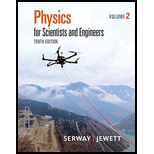
Review. In 1963, astronaut Gordon Cooper orbited the Earth 22 times. The press stated that for each orbit, he aged two-millionths of a second less than he would have had he remained on the Earth. (a) Assuming Cooper was 160 km above the Earth in a circular orbit, determine the difference in elapsed time between someone on the Earth and the orbiting astronaut for the 22 orbits. You may use the approximation
for small x. (b) Did the press report accurate information? Explain.
Trending nowThis is a popular solution!

Chapter 38 Solutions
Physics for Scientists and Engineers, Volume 2
- Ho propel 9-kN t. Boat 27. An elevator accelerates downward at 2.4 m/s². What force does the elevator's floor exert on a 52-kg passenger?arrow_forward16. 17 A CUIN Starting from rest and undergoing constant acceleration, a 940-kg racing car covers 400 m in 4.95 s. Find the force on the car.arrow_forward----- vertical diste Section 4.6 Newton's Third Law 31. What upward gravitational force does a 5600-kg elephant exert on Earth?arrow_forward
- 64. Two springs have the same unstretched length but different spring constants, k₁ and k₂. (a) If they're connected side by side and stretched a distance x, as shown in Fig. 4.24a, show that the force exerted by the combination is (k₁ + k₂)x. (b) If they're con- nected end to end (Fig. 4.24b) and the combination is stretched a distance x, show that they exert a force k₁k2x/(k₁ + k₂). www (a) FIGURE 4.24 Problem 65 www (b)arrow_forward65. Although we usually write Newton's second law for one-dimensional motion in the form F =ma, which holds when mass is constant, d(mv) a more fundamental version is F = . Consider an object dt whose mass is changing, and use the product rule for derivatives to show that Newton's law then takes the form F dm = ma + v dtarrow_forwardIf a proton is located on the x-axis in some coordinate system at x0 = -3.2 x 10-5 meters, what is the x-component of the Electric Field due to this proton at a position x = +3.2 x 10-5 meters and on the x axis as the y-axis is 0 giving a number of Newtons/Coulomb?arrow_forward
- Consider a single square loop of wire of area A carrying a current I in a uniform magnetic field of strength B. The field is pointing directly up the page in the plane of the page. The loop is oriented so that the plane of the loop is perpendicular to the plane of the page (this means that the normal vector for the loop is always in the plane of the page!). In the illustrations below the magnetic field is shown in red and the current through the current loop is shown in blue. The loop starts out in orientation (i) and rotates clockwise, through orientations (ii) through (viii) before returning to (i). (i) Ø I N - - I N - (iii) (iv) (v) (vii) (viii) a) [3 points] For each of the eight configurations, draw in the magnetic dipole moment vector μ of the current loop and indicate whether the torque on the dipole due to the magnetic field is clockwise (CW), counterclockwise (CCW), or zero. In which two orientations will the loop experience the maximum magnitude of torque? [Hint: Use the…arrow_forwardPlease help with calculating the impusle, thanks! Having calculated the impact and rebound velocities of the ping pong ball and the tennis ball calculate the rebounding impulse: 1.Measure the weight of the balls and determine their mass. Tennis ball: 0.57 kg Ping Pong Ball: 0.00246 kg The impulse, I, is equal to the change in momentum, Pf-Pi. Note the sign change, i.e., going down is negative and up is positive. The unit for momentum is kg-m/s. The change is momentum, impulse, is often givens the equivalent unit of N-S, Newton-Secondarrow_forward5. Three blocks, each with mass m, are connected by strings and are pulled to the right along the surface of a frictionless table with a constant force of magnitude F. The tensions in the strings connecting the masses are T1 and T2 as shown. m T1 T2 F m m How does the magnitude of tension T₁ compare to F? A) T₁ = F B) T₁ = (1/2)F C) T₁ = (1/3)F D) T₁ = 2F E) T₁ = 3Farrow_forward
- Using Coulombs Law, what is the magnitude of the electrical force between two protons located 1 meter apart from each other in Newtons?arrow_forwardCalculate the magnitude of the gravitational force between 2 protons located 1 meter apart from each other in Newtons using Newton's Law of Universal Gravitation.arrow_forwardIf the metal sphere on the Van de Graff has a charge of 0.14 Coulombs and the person has a mass of 62 kg, how much excess charge would the person need in order to levitate at a distance 25 cm from the center of the charged metal sphere if there is a distance 25 cm from the person to the sphere using Coulomb's Law to calculate the electrical force. Give your answer as the number of Coulombs (with no unit label, as usual).arrow_forward
 Principles of Physics: A Calculus-Based TextPhysicsISBN:9781133104261Author:Raymond A. Serway, John W. JewettPublisher:Cengage Learning
Principles of Physics: A Calculus-Based TextPhysicsISBN:9781133104261Author:Raymond A. Serway, John W. JewettPublisher:Cengage Learning An Introduction to Physical SciencePhysicsISBN:9781305079137Author:James Shipman, Jerry D. Wilson, Charles A. Higgins, Omar TorresPublisher:Cengage Learning
An Introduction to Physical SciencePhysicsISBN:9781305079137Author:James Shipman, Jerry D. Wilson, Charles A. Higgins, Omar TorresPublisher:Cengage Learning Physics for Scientists and Engineers: Foundations...PhysicsISBN:9781133939146Author:Katz, Debora M.Publisher:Cengage Learning
Physics for Scientists and Engineers: Foundations...PhysicsISBN:9781133939146Author:Katz, Debora M.Publisher:Cengage Learning University Physics Volume 1PhysicsISBN:9781938168277Author:William Moebs, Samuel J. Ling, Jeff SannyPublisher:OpenStax - Rice University
University Physics Volume 1PhysicsISBN:9781938168277Author:William Moebs, Samuel J. Ling, Jeff SannyPublisher:OpenStax - Rice University Physics for Scientists and Engineers, Technology ...PhysicsISBN:9781305116399Author:Raymond A. Serway, John W. JewettPublisher:Cengage Learning
Physics for Scientists and Engineers, Technology ...PhysicsISBN:9781305116399Author:Raymond A. Serway, John W. JewettPublisher:Cengage Learning Glencoe Physics: Principles and Problems, Student...PhysicsISBN:9780078807213Author:Paul W. ZitzewitzPublisher:Glencoe/McGraw-Hill
Glencoe Physics: Principles and Problems, Student...PhysicsISBN:9780078807213Author:Paul W. ZitzewitzPublisher:Glencoe/McGraw-Hill





